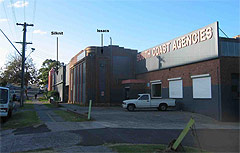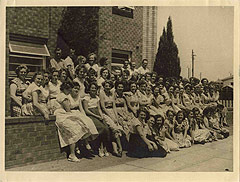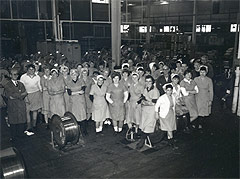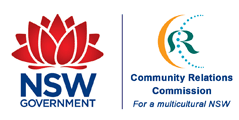by Louise Thom and Meredith Walker
 Isaacs and Silknit garment manufacturers, 2006. (Photo: M.Walker) |
The Illawarra Migration Heritage Project Inc recently embarked on a project to identify, document and assess migration heritage places in Wollongong. The population of Wollongong more than doubled between 1947 and 1961 due to migration yet previous heritage studies of Wollongong had not fully acknowledged migration as a significant historic theme in the City’s development. This study aimed to begin to address this oversight by investigating the migration heritage of the city in the post World War Two period. This will lead to a better understanding of places which are important due to migration.
The project investigated the impact post-World War Two migration had upon the development of the City of Wollongong. In particular the study investigated the themes of first places of accommodation, women’s work-places, Wollongong Harbour and worship.
First accommodation: When migrants arrived in Australia their first priority was to find a place to live. If they were displaced persons or assisted migrants accommodation was offered by government or arranged by community organizations, family or friends. Accommodation in the post war period in Wollongong was scarce. It was hard to find building materials and there were long delays in getting homes built. In response to the housing shortages and as part of their agreement with the settlement of migrants, hostels were constructed by industry and by the Commonwealth Government.
 Group of workers from Stamina (Isaacs) garment manufacturers 1954 (Photo: Courtesy of Olga Romano) |
Women’s Work Places: Finding work was another priority for migrants upon arrival. Work in Port Kembla steel and metal manufacturing industries together with the coal industry was readily available and attracted migrant men to Wollongong. This however led to a large workforce made up soley of men. Women who accompanied the men in their families to Wollongong on the otherhand had limited options and unemployment for women was high. The government attempted to overcome this problem by providing incentives for factories to move to Wollongong and other regional centres. The majority of factories subsequently built in Wollongong were garment manufacturers. The clothing industry became a major source of employment for women in the post war period.
“Working at Isaacs were the best days of my life. The bosses and the women – all the people; there were all sorts of migrants. I couldn’t understand Greek, Maltese, but I could work out what they wanted – Poles, Austrians, Germans.”
Olga Romano (Member of the MHPInc Committee)
Women also found work in the assorting room at the Tin Mill and at MM Kembla as well as in more traditional jobs such as in cleaning companies and service industries like cooking in the hostel kitchens.
 Group of workers in the wire products factory at Metal Manufacturers in Port Kembla circa 1964 (Photo courtesy of MM Kembla Products Ltd) |
Wollongong Harbour: Wollongong Harbour, also known as Belmore Basin has always been a working harbour. The Belmore Basin was constructed using convict labour and the harbour was the first place early colonists arrived when they travelled to Wollongong prior to construction of roads and railways linking the settlement to the rest of the colony. It was a working port where large shipments of coal were exported and at one stage it even had its own coke works. Today the harbour is home to a fishing fleet which has association with migrant families. It is also a place which has symbolic meaning for some migrant community groups. For instance the Macedonian Orthodox Church holds a traditional ceremony which links the church in Stewart Street to the harbour where a diving for the cross takes place.
Worship: The religious practices of each cultural group travelled with them to their new country. When work and home had been established then the communities could focus on creation of places to practise their faith. The large numbers of places of worship demonstrates the diversity of the migrant population of Wollongong. According to the Interfaith Harmony project there are at least 25 different religious affliliations in Wollongong. These include Macedonian, Greek and Russian Orthodox churches; Italian catholics of the Scalabrian order; Islam; Hindu; Buddhist and many others. The Church of the Immaculate Conception in Unanderra was the first one established by the Scalabrian order from Italy. The Reform Church in Fairy Meadow was built by the community and for many years had services in the Dutch language.
The study is made possible through the collaboration of the NSW Migration Heritage Centre, Wollongong City Council and the Heritage Office, Department of Planning (NSW) together with the Illawarra Migration Heritage Project Inc.

